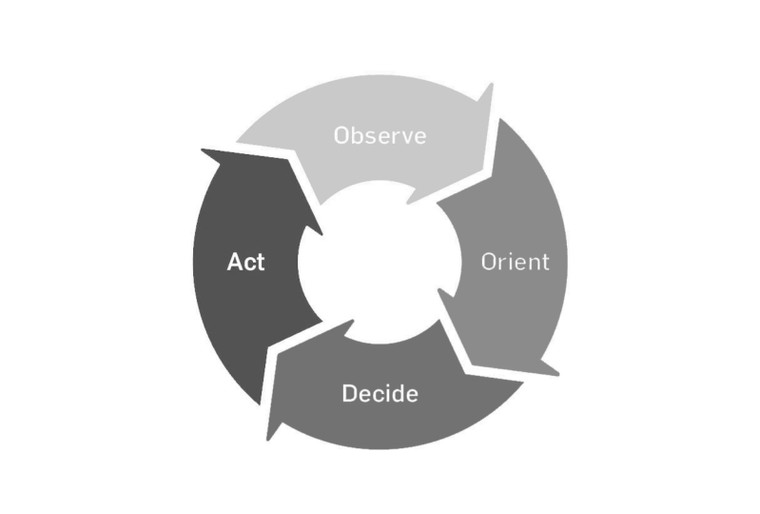Mastering the OODA Loop
Posted by Warrior Poet Society on Feb 9th 2024
It’s possible to learn the vital, critical-thinking skills that set you apart as a defender and operator, but this means honing, through training, the all-important ability to orient yourself in the midst of chaos. A lot of you reading this are probably already really good shooters. You likely have enough training and skill to hit what you want most of the time every time you're at the range. The key question now is, how do you deal with stress and chaos and other emerging variables while also trying to send rounds down range.
This is what I love about our classes when we transition into UTM (Ultimate Training Munitions) training. When we run drills with these training rounds, and we pile on the types of stress, confusion, and fear that you might see in a real-life gun battle, that's when some significant deficiencies emerge among our students.
The ability to make quick, life-or-death decisions in the moment is what sets apart the operators from the skilled shooters. And this highlights the supreme importance of the OODA Loop.
What is the OODA Loop?
The OODA Loop refers to the mental and nervous system framework that tactical and security professionals employ when engaging with a perceived threat. It's what law enforcement officers are trained to run through when deciding on the use of lethal force.
OODA stands for Observe, Orient, Decide, and Act.
It first came into heavy use by an Air Force fighter pilot named John Boyd, who's known within military communities as being one of the greatest tacticians of all time.
This GOAT had standing bets with his flight students that he'd pay good money to anyone of them who could gain an aerial advantage on him within 60 seconds without him turning the tables and gaining that advantage back. No one ever collected that money. No one ever won the bet.
This is because he had mastered what he considered the key skill of the four phases in the observe, orient, decide, act cycle.
Orienting Was the Key
Orienting yourself in the midst of the chaos is the most critical, yet difficult, of the four skills in the OODA Loop cycle. The ability to orient yourself requires a kind of Sherlock Holmes quality.
Most of us can see what we think might be a threat. We can observe. But to orient means to interpret and understand what you're seeing. "Is that a gun or a cell phone?" "Is this person lethally aggressive or just being a drunken fool?" "Is this attacker going to turn right or left in this kill house?"
It's one thing to see something unfolding, but being able to understand what's happening takes you to a whole new level of perception. Understanding and interpreting helps you assess what's unfolding, but, more important, it enables you to predict what might happen next.
You're able to know what's coming next. If you understand this, then it allows you to make a good decision. If you misunderstood this, you may make no decision or the wrong decision. So this is why developing the skill of orientation is so absolutely key to your capacity as an operator and defender.
Some of us are born with more of this than others. That's why there are elite operators and elite operators and chess masters.
But whether you've got the innate talent or not, it's possible and absolutely critical that you train your skills of orientation.
Training Your OODA Loop
In most situations, reading and interpreting a perceived threat begins with understanding body language.
If a guy is leaning back and staring into space in that dark alley that you shouldn't be walking down anyway, and he's making no move toward you, not evening acknowledging your existence, then you can probably just create distance and go on your merry way.
Maybe he’s just trying to have a cigarette.
If he’s got a bladed stance, dropped chin, furrowed brow, eyes cut, threat focused, cheated garment, shoulders rolled forward, weight on the toes, then you’ve got eight different threat indicators strewn together. Trouble is probably coming.
RELATED POSTS | Train with WPS • The Gift of Fear • Situational Awareness 101 • The Violence Gap
Of course, the body language isn’t always that clear. The context and environment are also key.
Is the situation already heightened with aggressive energy?
Is the place known for violent attacks?
Are the people you’re observing have motivation to harm you?
So within this context, is this person speed walking toward you for exercise or with ill intent?
Maybe the guy staring off into space is taking on a predatory stance and avoiding eye contact, like of like a bear does when it’s stalking you. But maybe he’s just awkward.
When it comes to mastering this key component of the OODA Loop, it’s possible that you’re born with the skills of a Sherlock Holmes to interpret and understand.
But if you’re like the most of us, this skill set requires exposure to chaos, experience with stressful tactical situations, and some very specific training to educate your mind and nervous system.
When a situation arises, the split-second decisions become more and more like those bullets in that movie The Matrix that Neo plucked from the air.
For this it’s critical to Train Hard. Train Smart. Hardwire the OODA Loop

